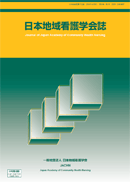Volume 5, Issue 2
Displaying 1-11 of 11 articles from this issue
- |<
- <
- 1
- >
- >|
-
Article type: Article
2003 Volume 5 Issue 2 Pages 34-42
Published: March 15, 2003
Released on J-STAGE: April 20, 2017
Download PDF (2486K) -
Article type: Article
2003 Volume 5 Issue 2 Pages 43-50
Published: March 15, 2003
Released on J-STAGE: April 20, 2017
Download PDF (1858K) -
Article type: Article
2003 Volume 5 Issue 2 Pages 51-60
Published: March 15, 2003
Released on J-STAGE: April 20, 2017
Download PDF (2611K) -
Article type: Article
2003 Volume 5 Issue 2 Pages 61-69
Published: March 15, 2003
Released on J-STAGE: April 20, 2017
Download PDF (1984K) -
Article type: Article
2003 Volume 5 Issue 2 Pages 70-78
Published: March 15, 2003
Released on J-STAGE: April 20, 2017
Download PDF (2386K) -
Article type: Article
2003 Volume 5 Issue 2 Pages 79-84
Published: March 15, 2003
Released on J-STAGE: April 20, 2017
Download PDF (2058K) -
Article type: Article
2003 Volume 5 Issue 2 Pages 85-89
Published: March 15, 2003
Released on J-STAGE: April 20, 2017
Download PDF (990K) -
Article type: Article
2003 Volume 5 Issue 2 Pages 90-94
Published: March 15, 2003
Released on J-STAGE: April 20, 2017
Download PDF (1008K) -
Article type: Article
2003 Volume 5 Issue 2 Pages 95-100
Published: March 15, 2003
Released on J-STAGE: April 20, 2017
Download PDF (1607K) -
Article type: Article
2003 Volume 5 Issue 2 Pages 101-108
Published: March 15, 2003
Released on J-STAGE: April 20, 2017
Download PDF (1713K) -
Article type: Article
2003 Volume 5 Issue 2 Pages 109-117
Published: March 15, 2003
Released on J-STAGE: April 20, 2017
Download PDF (2043K)
- |<
- <
- 1
- >
- >|
